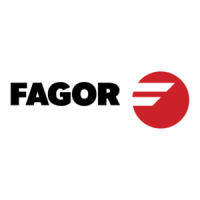·334·
Programming manual
CNC 8055
CNC 8055i
12.
PROBING
·M· & ·EN· MODELS
SOFT: V02.2X
PROBE 12. Tabletop probe calibration
[ V±5.5 ] Approximate Y axis coordinate of the most positive side of the probe
Approximate coordinate of the most positive side of the probe, along the ordinate axis. If not
programmed, it will assume the value of general machine parameter PRBYMAX (P43).
[ Z±5.5 ] Approximate Z axis coordinate of the least positive side of the probe
Approximate coordinate of the least positive side of the probe, along the Z axis. If not programmed,
it will assume the value of general machine parameter PRBZMIN (P44).
[ W±5.5 ] Approximate Z axis coordinate of the most positive side of the probe
Approximate coordinate of the most positive side of the probe, along the Z axis. If not programmed,
it will assume the value of general machine parameter PRBZMAX (P45).
Operation
1. Spindle orientation at 0º (only for double calibration).
2. Initial positioning movement to the initial approach coordinates.
3. Probing movement (at the feedrate given in H) up to the Z probing coordinate (in the middle of
the probe). If it touches the part, the CNC issues the corresponding error.
4. Probing movement (at the feedrate given in H), in the X axis and in the given direction until
touching the first side.
5. Rapid withdrawal along the X axis (distance given in E) for the measuring probing move.
6. Probing movement (at the feedrate given in F) until touching the same side again.
7. Rapid withdrawal up to the X approach coordinate.
8. Rapid withdrawal in Z up to the Z approach coordinate.
9. Rapid X axis movement up to the approach point of the other side considering the theoretical
length of the probe on the X axis and the value of parameter B.
10.Probing movement (at the feedrate given in H) to go down to the probing Z coordinate. If it
touches the probe, it goes back up to the approach coordinate and moves the safety distance
indicated in the same direction. This movement is repeated until clearing the probe.
11.Probing movement on X (at the feedrate given in H) until touching that side.
12.Rapid withdrawal along the X axis (distance given in E) for the measuring probing move.
13.Probing movement on X (at the feedrate given in F) until touching the same side again.
14.Rapid withdrawal up to the X approach coordinate.
15.Rapid movement along the Z axis up to the Z approach coordinate.
16.Rapid movement up to the approach coordinate to the minimum Y side of the probe (the X
approach coordinate corresponds to the real center of the probe).
17.Probing movement (at the feedrate given in H) to go down to the probing Z coordinate. If it
touches the probe, it goes back up to the approach coordinate and moves the safety distance
indicated in the same direction. This movement is repeated until clearing the probe.
18.Probing movement on Y (at the feedrate given in H) until touching that side.
19.Rapid withdrawal along the Y axis (distance given in E) for the measuring probing move.
20.Probing movement on Y (at the feedrate given in F) until touching the same side again.
21.Rapid withdrawal up to the Y approach coordinate.
22.Rapid movement in Z up to the Z approach coordinate.
23.Rapid movement along the Y axis up to the theoretical center of the probe.
24.Probing movement on Z (at the feedrate given in H) until touching the Z side of the probe.
25.Rapid withdrawal along the Z axis (distance given in E) for the measuring probing move.
26.Probing movement on Z (at the feedrate given in F) until touching the same side again.
27.Rapid movement along the Z axis up to the Z approach coordinate.
28.Rapid Y axis movement up to the approach point of the other side considering the theoretical
length of the probe on the Y axis and the value of parameter B.
29.Probing movement (at the feedrate given in H) to go down to the probing Z coordinate. If it
touches the probe, it goes back up to the approach coordinate and moves the safety distance
indicated in the same direction. This movement is repeated until clearing the probe.

